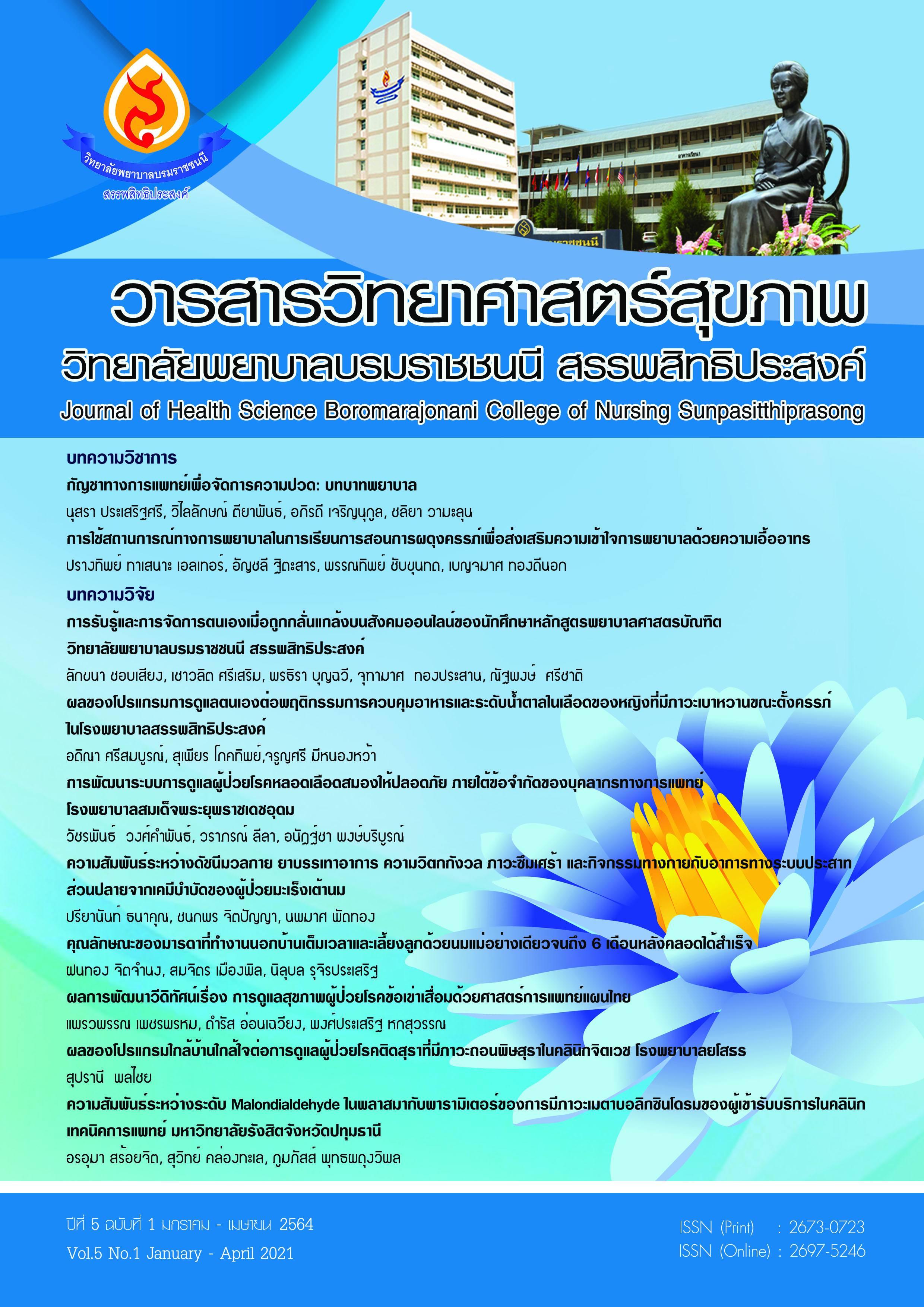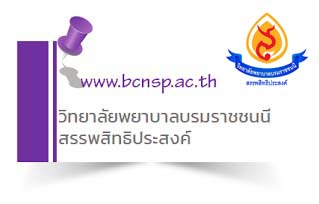กัญชาทางการแพทย์เพื่อจัดการความปวด: บทบาทพยาบาล
คำสำคัญ:
กัญชาทางการแพทย์, การจัดการความปวด, บทบาทพยาบาลบทคัดย่อ
ในปัจจุบันมีการใช้กัญชาทางการแพทย์เพื่อจัดการความปวด ขณะเดียวกันพบว่ามีหลักฐานเชิงประจักษ์ที่ขัดแย้งกันเกี่ยวกับการใช้กัญชาทางการแพทย์ในการจัดการความปวด พยาบาลเป็นบุคลากรทางสุขภาพที่สำคัญในการพยาบาลเพื่อจัดการความปวด อีกทั้งกัญชาทางการแพทย์ยังเป็นเรื่องที่ใหม่สำหรับพยาบาลไทย การพยาบาลจัดการความปวดด้วยกัญชาทางการแพทย์ พยาบาลต้องมีความรู้ความเข้าใจเกี่ยวกับการใช้กัญชาทางการแพทย์ในการจัดการความปวด วัตถุประสงค์ของบทความวิชาการนี้เพื่อทบทวนเอกสารที่เกี่ยวข้องเกี่ยวกับกัญชาทางการแพทย์เพื่อจัดการความปวด ซึ่งเนื้อหาประกอบด้วย กลไกของระบบกัญชาในร่างกาย เภสัชวิทยาของกัญชา งานวิจัยการใช้กัญชาในการจัดการความปวด และบทบาทพยาบาลในการใช้กัญชาทางการแพทย์ในการจัดการความปวดและการบูรณาการการวิจัยในการปฏิบัติทางคลินิก เพื่อสนับสนุนให้ผู้ป่วยเปิดเผยการใช้กัญชาได้อย่างมั่นใจและมีส่วนร่วมในการตัดสินใจร่วมกันเกี่ยวกับผลกระทบที่อาจเกิดขึ้นต่อสุขภาพของผู้ป่วย
เอกสารอ้างอิง
Bridgeman MB, Abazia DT. Medicinal cannabis: history, pharmacology, and implications for the acute care setting. Pharmacy and Therapeutics 2017;42:180.
สำนักงานคณะกรรมการอาหารและยา กองควบคุมวัตถุเสพติด กระทรวงสาธารณสุข. พระราชบัญญัติยาเสพติดให้โทษ (ฉบับที่ 7) พ.ศ. 2562 (ประกาศในราชกิจจานุเบกษา เมื่อวันที่ 18 กุมภาพันธ์ 2562) [อินเตอร์เน็ต]. 2562 [เข้าถึงเมื่อ 17 เม.ย. 2564]. เข้าถึงได้จาก: https://mnfda.fda.moph.go.th/narcotic/?p=3914
McPartland JM. Cannabis systematics at the levels of family, genus, and species. Cannabis and cannabinoid research 2018;3:203-12.
Appendino G, Gibbons S, Giana A, Pagani A, Grassi G, Stavri M, et al. Antibacterial cannabinoids from Cannabis sativa: a structure− activity study. Journal of natural products 2008;71:1427-30.
Abuhasira R, Shbiro L, Landschaft Y. Medical use of cannabis and cannabinoids containing products–Regulations in Europe and North America. European journal of internal medicine 2018;49:2-6.
Iseger TA, Bossong MG. A systematic review of the antipsychotic properties of cannabidiol in humans. Schizophrenia research 2015;162:153-61.
Chagas MHN, Zuardi AW, Tumas V, Pena-Pereira MA, Sobreira ET, Bergamaschi MM, et al. Effects of cannabidiol in the treatment of patients with Parkinson’s disease: an exploratory double-blind trial. Journal of Psychopharmacology 2014;28:1088-98.
Pisanti S, Malfitano AM, Ciaglia E, Lamberti A, Ranieri R, Cuomo G, et al. Cannabidiol: State of the art and new challenges for therapeutic applications. Pharmacology & therapeutics 2017;175:133-50.
Janero DR, Makriyannis A. Cannabinoid receptor antagonists: pharmacological opportunities, clinical experience, and translational prognosis. Expert opinion on emerging drugs 2009;14:43-65.
Di Marzo V. The endocannabinoid system: its general strategy of action, tools for its pharmacological manipulation and potential therapeutic exploitation. Pharmacological Research 2009;60:77-84.
Bermudez-Silva FJ, Cardinal P, Cota D. The role of the endocannabinoid system in the neuroendocrine regulation of energy balance. Journal of psychopharmacology. 2012;26:114-24.
Hua T, Vemuri K, Pu M, Qu L, Han GW, Wu Y, et al. Crystal structure of the human cannabinoid receptor CB1. Cell. 2016;167:750-62. e14.
Fonseca B, Costa M, Almada M, Correia-da-Silva G, Teixeira N. Endogenous cannabinoids revisited: a biochemistry perspective. Prostaglandins & other lipid mediators 2013;102:13-30.
Zogopoulos P, Vasileiou I, Patsouris E, Theocharis SE. The role of endocannabinoids in pain modulation. Fundamental & clinical pharmacology 2013;27:64-80.
Martin JH, Schneider J, Lucas CJ, Galettis P. Exogenous cannabinoid efficacy: merely a pharmacokinetic interaction? Clinical pharmacokinetics 2018;57:539-45.
Stout SM, Cimino NM. Exogenous cannabinoids as substrates, inhibitors, and inducers of human drug metabolizing enzymes: a systematic review. Drug metabolism reviews 2014;46:86-95.
Hazekamp A, Ware MA, Muller-Vahl KR, Abrams D, Grotenhermen F. The medicinal use of cannabis and cannabinoids—an international cross-sectional survey on administration forms. Journal of psychoactive drugs 2013;45:199-210.
Sharma P, Murthy P, Bharath MS. Chemistry, metabolism, and toxicology of cannabis: clinical implications. Iranian Journal of Psychiatry 2012;7:149.
Loflin MJ, Kiluk BD, Huestis MA, Aklin WM, Budney AJ, Carroll KM, et al. The state of clinical outcome assessments for cannabis use disorder clinical trials: A review and research agenda. Drug and alcohol dependence 2020:107993.
Mücke M, Phillips T, Radbruch L, Petzke F, Häuser W. Cannabis‐based medicines for chronic neuropathic pain in adults. Cochrane Cochrane Database Syst Rev 2018;3:CD012182. doi: 10.1002/14651858.CD012182.pub2.
Ablin J, Ste-Marie P, Schäfer M, Häuser W, Fitzcharles M-A. Medical use of cannabis products. Der Schmerz 2016;30:3-13.
Clem SN, Bigand TL, Wilson M. Cannabis use motivations among adults prescribed opioids for pain versus opioid addiction. Pain Management Nursing 2020;21:43-7.
De Gregorio D, McLaughlin RJ, Posa L, Ochoa-Sanchez R, Enns J, Lopez-Canul M, et al. Cannabidiol modulates serotonergic transmission and reverses both allodynia and anxiety-like behavior in a model of neuropathic pain. Pain 2019;160:136.
Hill KP. Medical use of cannabis in 2019. Jama 2019;322:974-5.
Stockings E, Campbell G, Hall WD, Nielsen S, Zagic D, Rahman R, et al. Cannabis and cannabinoids for the treatment of people with chronic noncancer pain conditions: a systematic review and meta-analysis of controlled and observational studies. Pain 2018;159:1932-54.
Hordowicz M, Klimkiewicz A, Jarosz J, Wysocka M, Jastrzębska M. Knowledge, attitudes, and prescribing patterns of cannabis and cannabinoid-containing medicines among European healthcare workers: a systematic literature review. Drug and Alcohol Dependence 2021:222;108652. doi: https://doi.org/10.1016/j.drugalcdep.2021.108652.
Palace ZJ, Reingold DA. Medical cannabis in the skilled nursing facility: A novel approach to improving symptom management and quality of life. Journal of the American Medical Directors Association 2019;20:94-8.
Wilson M, Klein T, Bindler RJ, Kaplan L. Shared Decision-Making for Patients Using Cannabis for Pain Symptom Management in the United States. Pain Management Nursing 2020:22;15-20. doi: https://doi.org/10.1016/j.pmn.2020.09.009.
ดาวน์โหลด
เผยแพร่แล้ว
รูปแบบการอ้างอิง
ฉบับ
ประเภทบทความ
สัญญาอนุญาต
บทความที่ได้รับการตีพิมพ์เป็นลิขสิทธิ์ของวารสารวิทยาศาสตร์สุขภาพ วิทยาลัยพยาบาลบรมราชชนนี สรรพสิทธิประสงค์ ข้อความที่ปรากฏในบทความแต่ละเรื่องเป็นความคิดเห็นส่วนตัวของผู้เขียนแต่ละท่านไม่เกี่ยวข้องกับวิทยาลัยพยาบาลบรมราชชนนี สรรพสิทธิประสงค์ และคณาจารย์ท่านอื่นๆ ในวิทยาลัยพยาบาลฯ ความรับผิดชอบเกี่ยวกับบทความแต่ละเรื่องผู้เขียนจะรับผิดชอบของตนเอง



